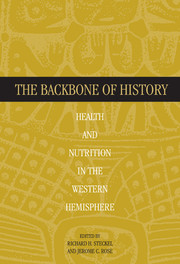Book contents
- Frontmatter
- Contents
- Preface
- List of Contributors
- PART I
- PART II METHODOLOGY
- PART III EURO-AMERICANS AND AFRICAN-AMERICANS IN NORTH AMERICA
- PART IV NATIVE AMERICANS IN CENTRAL AMERICA
- PART V NATIVE AMERICANS AND EURO-AMERICANS IN SOUTH AMERICA
- PART VI NATIVE AMERICANS IN NORTH AMERICA
- Introduction
- 14 A Biohistory of Health and Behavior in the Georgia Bight: The Agricultural Transition and the Impact of European Contact
- 15 Native Americans in Eastern North America: The Southern Great Lakes and Upper Ohio Valley
- 16 Cultural Longevity and Biological Stress in the American Southwest
- 17 Health, Nutrition, and Demographic Change in Native California
- 18 Welfare History on the Great Plains: Mortality and Skeletal Health, 1650 to 1900
- PART VII
- PART VIII
- PART IX EPILOGUE
- Index
18 - Welfare History on the Great Plains: Mortality and Skeletal Health, 1650 to 1900
Published online by Cambridge University Press: 01 March 2010
- Frontmatter
- Contents
- Preface
- List of Contributors
- PART I
- PART II METHODOLOGY
- PART III EURO-AMERICANS AND AFRICAN-AMERICANS IN NORTH AMERICA
- PART IV NATIVE AMERICANS IN CENTRAL AMERICA
- PART V NATIVE AMERICANS AND EURO-AMERICANS IN SOUTH AMERICA
- PART VI NATIVE AMERICANS IN NORTH AMERICA
- Introduction
- 14 A Biohistory of Health and Behavior in the Georgia Bight: The Agricultural Transition and the Impact of European Contact
- 15 Native Americans in Eastern North America: The Southern Great Lakes and Upper Ohio Valley
- 16 Cultural Longevity and Biological Stress in the American Southwest
- 17 Health, Nutrition, and Demographic Change in Native California
- 18 Welfare History on the Great Plains: Mortality and Skeletal Health, 1650 to 1900
- PART VII
- PART VIII
- PART IX EPILOGUE
- Index
Summary
ABSTRACT
The relationship between the longevity, health, and welfare of modern populations is difficult to assess, but all the complexities are multiplied when our evaluation must rely heavily on skeletal data from the remote past. This chapter uses skeletal data for several groups of Native American Indians who lived on the Great Plains of North America in the eighteenth and nineteenth centuries, to reconstruct their welfare history during the long process of contact with Europeans. The estimation of mortality involves putting the mean age-at-death for each group back into the relevant environmental, historical, and demographic contexts necessary to interpret that statistic as a true life expectancy. Subsequently, the growth-ratesensitive life expectancy estimaters are integrated with various dimensions of skeletal health to compare the relative welfare of the settled horticultural groups with equestrian nomads.
WELFARE HISTORY AND MORTALITY
Welfare history involves comparing different groups living in different times and places, and how they fared with respect to each other and ourselves (Steckel, 1995). Hunter-gatherers have been described as leading lives that were nasty, brutish, and short compared to our own, or healthier and better, albeit simpler. The invention of agriculture can be seen as a defensive response to climatic change, one that meant having to do more work for less food, or, alternatively, a fortunate innovation that raised material standards of living and life expectancy for all subsequent generations (Cohen and Armelegos, 1984; Cohen, 1989). “Civilization” may have improved or reduced the health and welfare of women and so on (Coatsworth, 1996).
- Type
- Chapter
- Information
- The Backbone of HistoryHealth and Nutrition in the Western Hemisphere, pp. 524 - 560Publisher: Cambridge University PressPrint publication year: 2002
- 3
- Cited by



